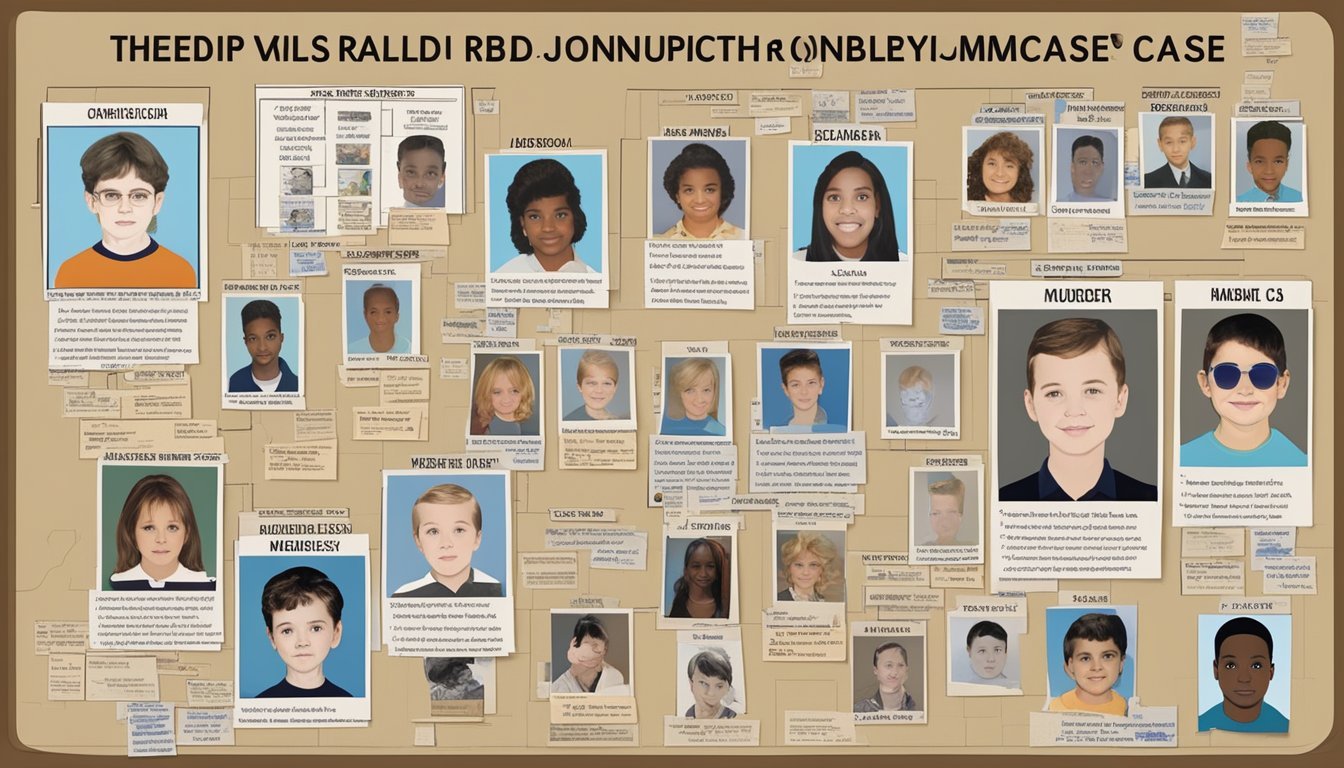Shocking Questions: Why Was JonBenét Ramsey Killed? The Disturbing Theories Behind Her Murder!
The unsolved murder of JonBenét Ramsey continues to captivate public interest nearly three decades after the tragic event. On December 26, 1996, the six-year-old beauty queen was found dead in the basement of her family's Boulder, Colorado home. Despite extensive investigations, the exact motive and perpetrator behind JonBenét's killing remain unknown.
The case has been plagued by conflicting evidence and theories. A ransom note found at the scene initially suggested a kidnapping, but JonBenét's body was discovered in the house hours later. She had suffered a skull fracture and strangulation. Investigators have explored various possibilities, including intruder theories and suspicions about family members, but no conclusive evidence has emerged to definitively solve the crime.
Over the years, advances in DNA technology have offered hope for a breakthrough. JonBenét's father, John Ramsey, believes that further DNA testing could finally provide answers. The Boulder Police Department and outside experts continue to review the case, seeking new leads that might shed light on this enduring mystery.
Background of JonBenét Ramsey
JonBenét Ramsey was a young child beauty queen from Boulder, Colorado. Her life and tragic death in 1996 garnered significant public attention and media scrutiny.
The Ramsey Family Profile
John and Patsy Ramsey were JonBenét's parents. John was a successful businessman, while Patsy was a former beauty queen. The family lived in a large home in Boulder, Colorado.
JonBenét had an older brother named Burke. The Ramseys were known for their affluent lifestyle and social standing in the community.
Patsy was actively involved in JonBenét's pageant career, often helping with costumes and preparations. The family's wealth allowed them to participate extensively in the child beauty pageant circuit.
JonBenét's Participation in Child Beauty Pageants
JonBenét began competing in beauty pageants at a young age. She participated in numerous events, winning titles such as "Little Miss Colorado" and "National Tiny Miss Beauty."
Her pageant performances often included singing, dancing, and modeling in elaborate costumes. JonBenét's participation in these events was a significant part of her short life.
The pageants exposed JonBenét to public attention from an early age. Some critics argued that her involvement in beauty contests was inappropriate for a child of her age.
JonBenét's pageant career ended abruptly with her death at age six, leaving behind a legacy of controversy surrounding child beauty pageants.
The Murder Case
The murder of JonBenét Ramsey on December 26, 1996 shocked the nation and remains one of America's most infamous unsolved crimes. The case involved a brutal attack on a 6-year-old child beauty queen in her own home, with puzzling evidence and conflicting theories.
Discovery of the Crime
JonBenét's mother, Patsy Ramsey, reported her daughter missing early on December 26. She claimed to have found a ransom note demanding $118,000 for the child's safe return.
Police searched the Ramsey home but found no signs of forced entry. Hours later, John Ramsey discovered JonBenét's body in the basement.
The child had been strangled with a garrote and suffered a skull fracture. There were signs of sexual assault. The brutality of the crime against such a young victim horrified the public.
Crime Scene Examination
Investigators faced challenges at the crime scene. The house had not been properly secured, allowing friends and family to move freely through it. This potentially contaminated evidence.
Key pieces of evidence included the ransom note, found to be written on paper from the Ramsey home. DNA was recovered from JonBenét's clothing, but it did not match anyone in the family.
The basement window showed signs of disturbance, but experts disagreed on whether an intruder had entered there. Fibers and hair samples were collected, but their significance remains debated.
Investigation Overview
The JonBenét Ramsey murder investigation has been ongoing for nearly three decades. It involves multiple law enforcement agencies, numerous suspects, and a complex web of evidence.
Initial Response and Challenges
Boulder Police Department responded to the Ramsey home on December 26, 1996, after JonBenét was reported missing. The initial search failed to locate the child. Her body was discovered in the basement later that day by her father, John Ramsey.
The crime scene was compromised due to the large number of people present in the house. This made evidence collection difficult and contaminated potential DNA samples.
Investigators faced criticism for their handling of the case. They were accused of focusing too narrowly on the Ramsey family as suspects early on, potentially overlooking other leads.
Evolving Leads and Suspect Pool
Over the years, the investigation has explored numerous theories and suspects. The Ramsey family, including parents John and Patsy, were under scrutiny for years but were eventually cleared by DNA evidence in 2008.
Other persons of interest have included family friends, household staff, and even a local Santa Claus impersonator. DNA evidence found on JonBenét's clothing did not match any known suspects.
Law enforcement has utilized advanced DNA testing techniques in attempts to identify the killer. Despite thousands of interviews and countless leads, the case remains unsolved.
The Boulder Police Department continues to investigate, collaborating with state and federal agencies. They regularly review evidence using new technologies in hopes of making a breakthrough.
Key Evidence Collected
The JonBenét Ramsey murder investigation yielded several crucial pieces of evidence. These items provided investigators with potential clues about the perpetrator and the circumstances surrounding her death.
The Ransom Note
A three-page ransom note was discovered on the stairs of the Ramsey home. The note demanded $118,000 for JonBenét's safe return. It was written on paper from a notepad found in the house.
Handwriting analysis was inconclusive in identifying the author. The note's length and detailed content were unusual for a kidnapping scenario.
Investigators noted that the ransom amount matched John Ramsey's recent bonus, suggesting the writer had inside knowledge of the family's finances.
DNA Analysis
DNA evidence played a significant role in the investigation. Unidentified male DNA was found on JonBenét's underwear and leggings.
This DNA did not match any family members or known suspects. It became a key focus of the investigation and subsequent testing.
In 2008, advanced DNA techniques isolated a male genetic profile. This profile was entered into the FBI's Combined DNA Index System (CODIS) but has not yet yielded a match.
The Autopsy Findings
The autopsy revealed crucial details about JonBenét's cause of death. She suffered a skull fracture from a blow to the head and had been strangled with a garrote.
The garrote was constructed from cord and a broken paintbrush handle found in the house. JonBenét also had marks on her body consistent with the use of a stun gun.
Toxicology reports showed no drugs or foreign substances in her system. The autopsy estimated her time of death as between 10 p.m. on December 25 and 2 a.m. on December 26, 1996.
Profile of Potential Suspects
Multiple individuals have been investigated as potential suspects in JonBenét Ramsey's murder. The case has considered family members, possible intruders, and other persons of interest.
Family Members
John and Patsy Ramsey, JonBenét's parents, faced intense scrutiny. Investigators initially viewed them as prime suspects due to inconsistencies in their statements and unusual behavior.
Patsy Ramsey's handwriting was analyzed in connection with the ransom note found at the scene. Some experts claimed similarities, while others disagreed.
JonBenét's brother Burke, nine years old at the time, was also investigated. Theories suggested sibling rivalry or an accidental injury covered up by the parents.
Despite suspicions, no family member has ever been charged. DNA evidence found on JonBenét's clothing did not match any family members.
Intruder Theory
The intruder theory suggests an outsider broke into the Ramsey home and committed the crime. Supporters point to unidentified DNA found on JonBenét's clothing.
A broken basement window and scuff marks on a wall lend credence to this theory. Some argue the ransom note's length indicates the perpetrator spent considerable time in the house.
Critics contend there were no signs of forced entry and question how an intruder could navigate the house undetected.
Other Notable Suspects
John Mark Karr, a schoolteacher, falsely confessed to the murder in 2006. His claims were quickly discredited by lack of evidence and inconsistencies in his story.
Gary Oliva, a convicted pedophile, lived near the Ramsey home. He allegedly made incriminating statements about JonBenét's death, but no charges were filed.
A local Santa Claus impersonator who visited the Ramsey home days before the murder was briefly considered a person of interest.
Despite numerous leads and suspects over the years, the case remains unsolved. Investigators continue to explore new avenues as technology advances.
Legal Proceedings and Grand Jury
The JonBenét Ramsey case involved complex legal proceedings, including a grand jury investigation. Key developments centered around the grand jury's deliberations and the legal situation of JonBenét's parents, John and Patsy Ramsey.
Grand Jury Deliberations
A grand jury convened in 1999 to examine evidence in the JonBenét Ramsey murder case. The jury's proceedings were kept secret for many years. In 2013, previously sealed documents from the grand jury were released to the public.
These documents revealed that the grand jury had voted to indict John and Patsy Ramsey on charges of child abuse resulting in death. However, the district attorney at the time declined to sign the indictment, citing insufficient evidence.
A grand juror who served on the case later spoke out in a televised interview, claiming to know who murdered JonBenét. The juror's identity was protected to maintain anonymity.
Ramseys' Legal Situation
John and Patsy Ramsey faced intense scrutiny throughout the investigation. They were interviewed by police and spoke to reporters about their daughter's murder. The couple maintained their innocence throughout the ordeal.
In 1999, the grand jury accused the Ramseys of placing JonBenét in a situation that posed a threat to her life or health. Despite this, formal charges were never filed against them.
Years later, in 2008, the Boulder District Attorney's office officially exonerated John and Patsy Ramsey based on new DNA evidence. This exoneration came too late for Patsy Ramsey, who had passed away in 2006.
The case remains unsolved, with no one charged for JonBenét's murder.
Cold Case Status and Developments
The JonBenét Ramsey case remains unsolved after nearly three decades. Recent advancements in forensic technology and continued public interest have sparked renewed efforts to uncover the truth behind her murder.
Modern DNA Testing Techniques
Advanced DNA analysis methods offer new hope for identifying JonBenét's killer. Genetic genealogy, which helped solve the Golden State Killer case, is now being applied to the Ramsey investigation. This technique compares crime scene DNA to genetic databases, potentially revealing familial connections to the perpetrator.
Investigators are also re-examining previously collected evidence using more sensitive DNA extraction methods. These techniques can detect trace amounts of genetic material that may have been missed in earlier tests.
The Colorado Cold Case Team is actively pursuing these new avenues of investigation. They believe that with current technology, even small amounts of DNA could provide crucial leads.
Ongoing Public Interest
JonBenét's case continues to captivate the public, fueling demands for resolution. True crime documentaries, such as "Cold Case: Who Killed JonBenét Ramsey?", have reignited interest in the investigation.
This sustained attention has led to:
Increased pressure on law enforcement to solve the case
New tips and information from the public
Fundraising efforts to support private investigations
JonBenét's father, John Ramsey, has been vocal in calling for the use of advanced DNA testing. His advocacy has helped keep the case in the spotlight and push for the application of new investigative methods.
Social media platforms have become hubs for case discussions, with amateur sleuths sharing theories and analyzing evidence. While some of these efforts may be misguided, they demonstrate the enduring public engagement with the case.
Cultural Impact and Media
The JonBenét Ramsey case captivated public attention and left a lasting mark on American culture. It sparked intense media coverage and fueled a surge in true crime content across various platforms.
True Crime Narratives
The Ramsey case became a defining moment in true crime storytelling. News outlets provided round-the-clock coverage, turning the investigation into a national spectacle. The public's fascination with the case led to a proliferation of true crime podcasts, TV shows, and online forums dedicated to discussing theories and evidence.
This media frenzy shaped public perception and influenced the investigation itself. Intense scrutiny fell on the Ramsey family, particularly JonBenét's parents, as suspicion and speculation ran rampant in the press.
Documentaries and Books
Numerous documentaries and books have explored the Ramsey case over the years. These works range from in-depth investigative pieces to more sensationalized accounts. Notable documentaries include "The Case of: JonBenét Ramsey" and the recent Netflix series "Cold Case: Who Killed JonBenét Ramsey?"
Authors have penned bestselling books examining different angles of the case. Some focus on the investigation itself, while others delve into the psychological impact on the Ramsey family and the Boulder community.
These productions continue to generate interest in the case, introducing new generations to the unsolved mystery and keeping JonBenét's story in the public consciousness nearly three decades later.
Public Opinion and Theories
The JonBenét Ramsey case has sparked intense public interest and numerous theories about what happened on that fateful night. Opinions range from mainstream views to more alternative explanations.
Mainstream Opinions
Many people believe JonBenét's parents were involved in her death. This theory gained traction due to inconsistencies in their statements and behavior after the murder. Some speculate it was an accident covered up to look like an intruder attack.
Another prevalent opinion points to an unknown intruder. Supporters of this theory cite evidence of forced entry and DNA from an unidentified male found on JonBenét's clothing.
Law enforcement officials have also been suspected of bungling the investigation, potentially allowing the real killer to escape justice.
Alternative Theories
Some theories suggest JonBenét's brother Burke was responsible, either accidentally or intentionally. This idea gained attention after a CBS documentary presented evidence supporting it.
Other alternative explanations include:
A pedophile ring targeting child pageant contestants
A botched kidnapping attempt
A conspiracy involving high-ranking officials
Filmmaker Joe Berlinger explored various theories in his docuseries "Unspeakable Crime: The Killing of JonBenét." The show examined evidence and interviewed key figures, presenting multiple perspectives on the case.
These diverse theories reflect the public's continued fascination with the unsolved murder and the desire to make sense of a tragic event.







